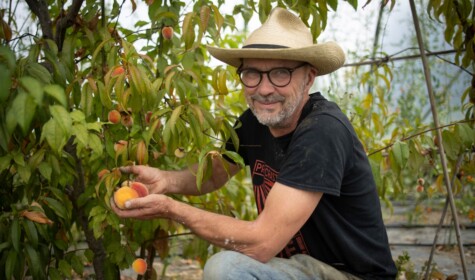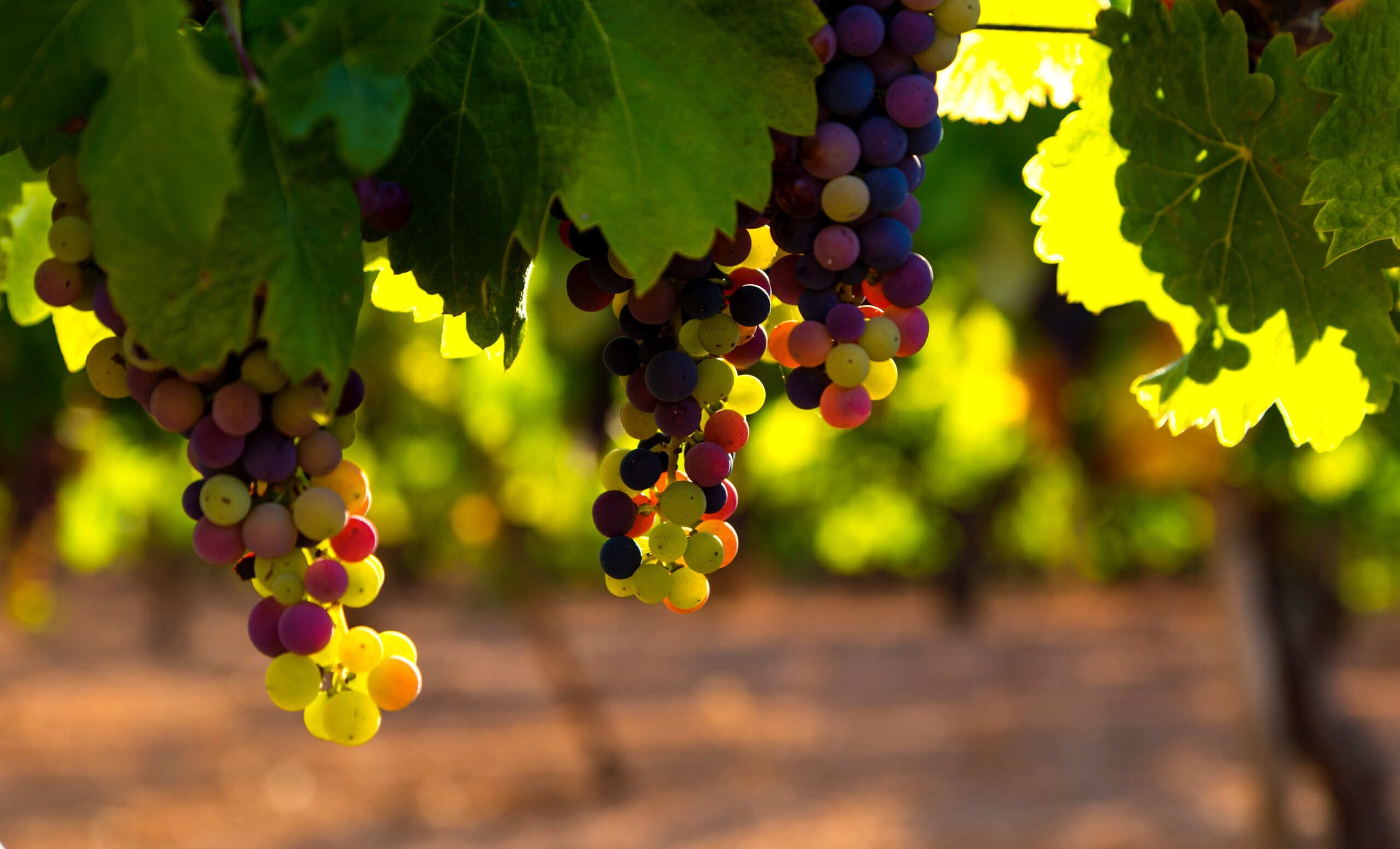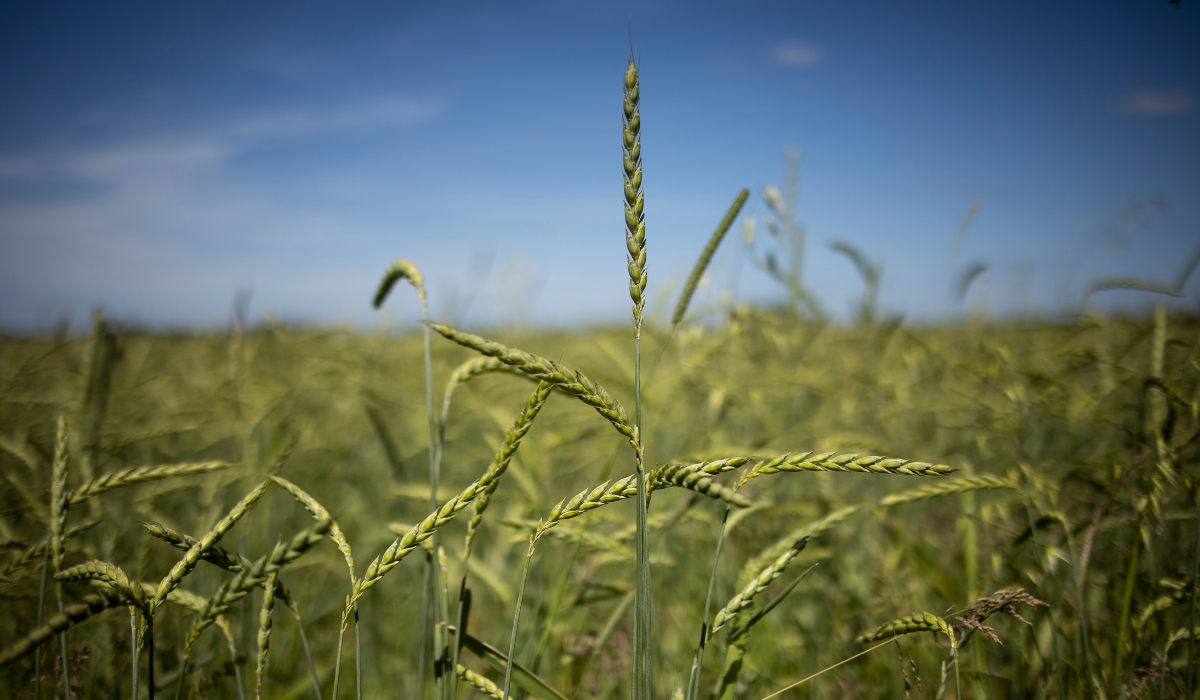- VICTORIA HALLIDAY

As our climate changes, farmers are branching out when it comes to decisions on what they should grow. Here, we look at some crops that might fare well as UK temperatures increase, and consider how these might fit into a more sustainable farming system.
On a farm in West Wales, Nathan Richards (pictured) is beginning to harvest his first small commercial crop of peaches and nectarines. These crops, along with apricots and cherries, are part of an experiment exploring future opportunities for polytunnel-grown stone fruit in the UK. He is interested not only in seeing if these crops are viable in our changing climate, but also trying to make best use of polytunnels’ warmth and vertical space. With the effects of climate change already being felt around the world, farmers like Nathan are increasingly turning their attention to ways that they can adapt, ensuring that they can continue to feed their customers locally grown produce that previously may only have been available on import.Changes in global temperatures and disruption of regional weather patterns pose a major threat to global food security. Simultaneous harvest failures across major crop-producing regions are increasingly likely, linked to a strongly meandering jet stream which can trigger concurrent extreme weather events. Crops like maize – the primary staple food for many of the world’s people, particularly in lower latitudes – are especially at risk; by the end of the century, it’s possible that maize production could drop by as much as 24% .
Wheat, on the other hand, tends to be grown in more temperate regions and benefits more than maize does from increased concentrations of carbon dioxide in the atmosphere. As a result, wheat production is expected to increase by up to 18% in the same period. These trends highlight the global inequalities of climate change when it comes to impacts on food production, with some staples at greater risk than others.
A recent study looking at sub-Saharan Africa, a region where climate change is compounding difficulties in producing enough food for a fast-growing population, suggests that the answer could lie in crop diversification. Maarten van Zonneveld and his team found that embracing ‘forgotten food crops’, including varieties of leafy vegetables, fruits, cereals, pulses and tubers, could support the ‘double-win’ of more climate-resilient and nutrient-rich food production in the sub-Saharan region.
Choosing crops that will be able to feed us in a changing climate is essential in all of the world’s regions, including here in the UK. Although some predictions show that certain traditional UK-grown staples, like wheat, may have a degree of resilience to climate change, our food supply is far from immune to the shocks of a warming planet particularly given our heavy reliance on foods grown by farmers in other parts of the world.
So, which crops might flourish as we seek to diversify for resilience? Here, we look at four potential candidates.
1. Stone fruit
While plums can flourish in the UK’s temperate climate, other stone fruits, like apricots and nectarines, are more sensitive to weather conditions. Their flowers appear on trees early in the year and are easily damaged by frost, and the fruit needs plenty of sun to ripen. These crops are difficult to produce in more northern latitudes, and they are typically grown in countries such as Turkey, Morocco, Italy and France, and imported to cooler, less sunny countries.However, there are hopes that these fruits might become easier to grow in countries like the UK as temperatures increase, potentially opening up a new market for farmers and enabling consumers access to fruit that hasn’t been shipped long distances.

Nathan says, “As we start to see and feel the effects of climate change, we as organic farmers must, as always, take the long view. It seems that with any relatively slow-to-produce foods, such as fruit trees, this is the time to be starting the process, and coming back from market on Monday having sold over a hundred ‘Costa Ceredigion’ peaches in 20 minutes, I am certainly glad that we have started the experiment.”
For all his enthusiasm about these trials, Nathan is still very aware that to scale up production would take significant infrastructure and investment which can be a gamble. However, he believes now is the time that we should be investing in this further diversification of what we might be growing in the changing UK climate.
2. Grapes
Having been grown since Roman times for winemaking, grapes are not a new introduction to England and Wales. The Romans’ vineyards were established during a period with a relatively warm climate and extended as far north as Northamptonshire and Lincolnshire. The Domesday Book mentioned over 40 vineyards in medieval England.Today, there are over 900 individual vineyards in the British Isles, extending from the Isles of Scilly to Aberdeenshire. The warming climate is creating conditions more suited to wine production, enabling British winemakers to produce a wide variety of still and sparkling wines from grape varieties that were previously not possible, or very difficult, to grow, including Pinot Noir, Chardonnay and Riesling. This production is anticipated to rise considerably over the next few decades.
Does increased wine production have a place in a more sustainable food and farming system? On the one hand, homegrown wines offer farmers a potentially lucrative new avenue for diversification and enable customers to reduce the amount of food miles connected with the produce that they buy while supporting local businesses.

A caveat is that many new vineyards are large-scale operations requiring significant investment, which are being set up by big producers from established wine regions. Increased competition for land in areas newly suited to winegrowing may push the cost of land beyond the reach of smaller-scale farmers and market gardeners who are focused on producing essential food crops.
Wine production has been synonymous with high chemical inputs, particularly fungicides. However, the burgeoning market for low-intervention, biodynamic and organic wines offer a more hopeful horizon for sustainable viticulture.
3. Landrace cereals
Landrace wheat varieties contain the diversity that’s needed for resilience in a changing climate. These are ancient versions of the standardised crops that now make up a large part of our diets. Rather than the carefully controlled breeding associated with modern wheat varieties, landrace crops are allowed to grow and pollinate at will, meaning that they self-select which plants survive and are constantly evolving in a way that is attuned with their growing conditions.An example is the YQ (Yield and Quality) variety of wheat, which is now grown by many farmers. Wakelyns, one of the parties involved in YQ’s initial development, explains, “each of those emigrant populations, like human communities who move across the world, will then have developed its own genetic characteristics, adapting to its new home. That’s how populations thrive in nature.”

Given the dominance of big companies over seed supplies (Bayer, Corteva, BASF and ChemChina/Syngenta now control more than 50% of the global commercial seed market) it is encouraging to see the resurgence of interest in diverse, locally adapted cereals. This is something that Becky Holden recently wrote about in her article on growing black oats at Bwlchwernen Fawr (Holden Farm Dairy):
“The vision is not just to preserve these rare grain varieties but to revive them and to see them grown and processed widely to feed people and livestock, just as they were traditionally…Given how successfully [the black oats] have grown in our fields, we can really start to imagine a resilient landscape of heritage oats replacing the bought-in grain seed on the farm, in just a few harvests.”
4. Chickpeas
Rich in protein, fibre and dietary minerals, chickpeas can fix their own nitrogen and can cope with more water and heat stress – all big advantages as we struggle with declining soil quality and higher temperatures. The UK’s first commercial chickpea crop was harvested in 2019, prompting a surge of interest in the crop’s potential to thrive in the country’s warming climate.
However, these early crops have met with varying success due to weather conditions that have fluctuated wildly from one growing season to the next. Writing for Hodmedod’s, co-founder, Josiah Meldrum, says, “The fact is climate change – or perhaps more accurately climate chaos – brings greater uncertainty and more frequent extremes, not a gentle slide to a new steady state. What works in Norfolk now will almost certainly be a heck of a lot more difficult in a decade or so, and there are unlikely to be straightforward crop substitutions – system changes rather than just dropping lentils or chickpeas into existing rotations. So, it’s critical that we find crops that as well as being part of an adaptive process can also contribute to lower input and lower impact food and farming systems.”
Despite these challenges, hopes remain high for UK-grown chickpeas in the future. As Josiah explains, “chickpeas are a marginal crop in the UK and when we first tried them, they seemed very risky – more likely to fail than succeed. It feels like that’s changing and the likelihood of success is weighted slightly in our favour now”.
The long-term forecast: risks and opportunities
Diversity and adaptability are crucial to producing enough food in a changing climate. These are also both features of more sustainable approaches to farming – ones that are sensitive to regional growing conditions and suited to smaller-scale, decentralised production.The crops listed above are just a few examples of how we might shift our perspective on what is viable to grow within a given region. They offer us hope by showing how we can take positive action to respond to the enormous challenges of climate change. At the same time, the risks posed by our increasingly erratic weather must not be underestimated and, while some of these crops might flourish, the outlook for others is sobering, with potatoes, onions and native varieties of apples all at high risk of significantly reduced yields or even extinction.
Of course, climate alone does not determine food security. Other factors such as agricultural practices, dietary choices, political and socio-economic shifts, and the general state of nature will also play a role in the degree to which farms are able to meet the dietary needs of the population. One thing is certain: farmers will have to adapt, and it is essential that they receive the support that will enable them to do so.





